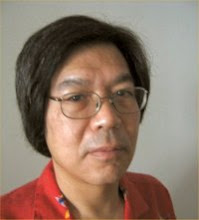Well, it's another National Weather Service understatement: the initial claim was that it would rain on Sunday and clear up for the rest of the week. Well: it's now Tuesday, and the drizzle and rain haven't stopped yet. It's just so dreary....
But yesterday, i watched the screener of "Hannah Takes the Stairs", so now i can be all up on the conversation about the "mumblecore" generation of filmmakers. (If there's anything i've learned, it's never make a statement in jest that can be used again and again; if there's anything to be learned from Yvonne Rainer's example, it's never issue a manifesto, because it'll just be used again and again, as if you had no right to develop from that point, her "minimalist" manifesto, the infamous "NO to...." which originally appeared in the Tulane Drama Review - which has since become The Drama Review - and it's as if her work was stunted at that point, which i don't think is true.) But it was interesting to see it on the same day that TCM played the 1942 "My Sister Eileen" (it's first broadcast in more than a decade, if i'm not mistaken), because (of course) "My Sister Eileen" is the prototype of the young-woman-in-the-big-city genre. And how times have changed! In the first scene of "Hannah Takes the Stairs", Hannah and her boyfriend are taking a shower together.
I also watched "Design for Scandal". It's amazing how many professional women Rosalind Russell played in the 1940s: magazine editors and lawyers and judges and on and on. But the process that began in the 1950s was distressing: she had been an actress who was tough, she wasn't some demure heroine (that's the problem with her MGM years) but a woman who was the equal of the men around her (that's certainly true in "His Girl Friday"). But by the 1950s, she wanted audiences to like her, and her work got distressingly soft (cf. "Auntie Mame", "A Majority of One", "The Trouble With Angels"). What's terrible is that the same thing happened to Katharine Hepburn. What was it with these actresses? But then you see Russell in "My Sister Eileen", and she's just as acerbic and sharp and funny as ever.
Also went to the press screening of "Vanaja". It's the kind of movie that is difficult to explain... but like "Once" or "Colma" or "The Wayward Cloud" or "Antonia", it is a movie in which "music" is integral. And it's a movie that proves that "musicals" don't have to be formulaic. ("Vanaja" is a good contrast to "Marigold"; in the latter, the Bollywood tradition is mimicked, while in "Vanaja" the traditional Indian musical forms are featured.)
The brouhaha has died down about Ingmar Bergman and Michelangelo Antonioni. But it was exciting for a while, because it provoked a lot of writing, and it reminded me of the time when people would get so excited by a movie.
But people still do: the press screening for David Lynch's "Inland Empire" was an example. It was a huge audience (the press screening was held at Alice Tully Hall during last year's New York Film Festival) and, yes, after about an hour, there was a slow trickle of walk-outs. ("Inland Empire" is hard to take in many ways.) But those who stayed, stayed to cheer. And i mean cheer.
In the NY Times today, there's an article about the very slow roll-out that will be given Todd's "I'm Not There", his biopic about Dylan. Actually, i can't wait to see it.
Dave Kehr's DVD review is about Luis Bunuel: there's the Lionsgate boxset of "Gran Casino" and "The Young One" (now the film seems almost classical, but i remember seeing it in the 1960s, and it seemed very scuzzy, almost unsavory... again, how times have changed) and the Criterion release of "The Milky Way".
This reminds me of George Robinson's comments about Bunuel on his blog (www.cine-journal.blogspot.com), which is that Bunuel is one of the most consistent filmmakers in history, though there is no single "masterwork" that people point to, the way they point to "The Searchers" for Ford, or "Citizen Kane" for Welles... and maybe that's why Bunuel is usually underrepresented in those polls about "the greatest films" because there are many choices (depending on your interest): there's "Un Chien Andalou" and "L'Age d'Or", there's "Las Hurdes" and "Los Olvidados", there's "Nazarin", there's "Viridiana", there's "Belle de Jour", there's "The Discreet Charm of the Bourgeoisie"....
In a way, i think that this whole Bergman fuss has been instructive, because so many of us (consciously or unconsciously) have internalized a very specific aesthetic... it's like the beginning of P. Adams Sitney's essay on Bresson (first published in the Anthology Film Archives reader Sitney edited for NYU Press and reprinted in the monograph that James Quandt edited for the Cinematheque Ontario), where he delineates the difference in approaches to cinema. It's the beginning of the essay "The Rhetoric of Robert Bresson" and i'll quote it here: "There are two irreconcilable critical paths open to the film critic. One takes cinema to be the heir to the nineteenth-century literary tradition, specifically the novel with its popular base. According to this tradition, Alfred Hitchcock, John Ford, Jean Renoir, and Josef von Sternberg are among the greatest artists of the cinema. I subscribe to the other view that sees cinema as a modern art and values it for its freedom from traditional fictional forms and for its intensity. The pantheon of this approach is more contestable, because the critics who share it are less willing to acdcept an orthodoxy. Nevertheless, the early Bunuel, some Russians from the twenties (Eisenstein, Dovzhenko, Vertov), Vigo, and some of Dreyer would probably be universally acknowledged."
Though i tend to be more eclectic, my affinities will always be with the modernist aesthetic.
But what does modernism in film look like now? "Hannah Takes the Stairs"? Well, we'll see what "I'm Not There" looks like....


0 Comments:
Post a Comment
<< Home